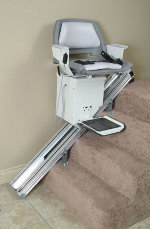A Stair Lift Primer
Published by Stephen on May 12, 2010 Under stair lifts Seniors who are unable to walk, or do so only with difficulty, are often times unable to safely use the stairs. This can occur when a disease like arthritis makes it more difficult for them to raise their knees and is also often related to poor or limited vision. This results in a much larger risk of falling and injuring ones self when using the stairs, so stair lifts are often used to increase safety.
Seniors who are unable to walk, or do so only with difficulty, are often times unable to safely use the stairs. This can occur when a disease like arthritis makes it more difficult for them to raise their knees and is also often related to poor or limited vision. This results in a much larger risk of falling and injuring ones self when using the stairs, so stair lifts are often used to increase safety.
Stair lifts have been around for awhile and were actually first developed more than eighty years ago, but the modern stair lift did not become popular until the 1990′s. A stair lift is used to move someone up or down the staircase, typically in a small plastic chair that moves along a metal track attached to the staircase.
The type of staircase determines what type of stair lift can be used, with special stair lifts needed for curved staircase, as well as ones that have one or more ninety degree bends.
In the case of the latter, staircases that have bends that make them “L” shaped, there are several do-it-yourself stair lift kits available. As with straight stair lifts, these DIY Stair Lift Kits are not as expensive as other lifts and easy to install.
Of course, most medical supply companies offer a professional stair lift installation service, but there are many kits available that can be installed with only normal tools and basic construction skills. The largest part of the stair lift installation is usually installing the metal track, which is attached either to the steps or the wall. Elevators, on the other hand, require a shaft between floors is built, as well as the lifting system safely secured in the ceiling, which is quite expensive.
In part, choosing between an electric stair lift, or an AC Stair Lift , and a Battery powered stair lift, or DC Stair Lift, comes down to cost, as DC Stair Lifts are more expensive. This is because a DC Stair Lift is powered off of a recharging battery, which will stay charged as long as the stair lift is plugged in. So, if there is a storm or the home looses power, a DC Stair Lift can still be used.
An AC Stair Lift is powered directly from the electrical outlet, so if the power goes out it will stop working. It ends up costing less than a DC Stair Lift and because there are no batteries to replace, there is a lower maintenance cost. However, not being able to use the stair lift in the event of an emergency does present a safety concern and is one of the reasons many people opt for a Battery Powered Stair Lift.
Unfortunately, stair lifts are one of the few devices not covered by Medicare. They are not considered durable medical equipment, which is a term used to describe things like wheelchairs and mobility scooters, but is instead classified as a home modification and not covered. This is similar to an elevator or the widening of doorways.
Stair lifts cost a lot less than an elevator and can often be installed easily by the homeowner. Since a simple hand control is used, most seniors do not have difficulty using them, but seat belts and shoulder restraints are also available for most stair lifts.
No Comments |
Add a Comment